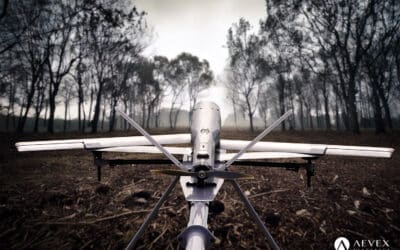The Differences Between IMU and INS
This post, the first in a multi-part series of technical blogs, is dedicated to covering the details at the core of the AEVEX Aerospace Geodetics Products Geo-MMS product line: our navigation module. The overall Geo-MMS system accuracy is a function of the navigation module performance – providing highly accurate positional and inertial information for direct-georeferencing of captured LiDAR data and geotagging captured imagery. Positional accuracy is typically determined by the GPS solution quality (see previous blogs dedicated to RTK-PPK techniques), while attitude accuracy is determined by the quality of the onboard IMU sensor.
Let’s examine in more detail the IMU (Inertial Measurement Unit) sensor and the differences between IMU and the INS (Inertial Navigation System). IMU represents only the sensor, while the INS is the process through which the IMU measures data and converts it to navigation data (position, velocity, attitude, and acceleration). The fundamental operation of an inertial system is based on Newton’s law of inertia – describing the mechanism of motion in space, as follows: all objects that have mass are inert. Inertia is the tendency of an object to resist the change of speed. If the speed changes, it is said that the object is accelerating. An instrument which can measure acceleration is called an accelerometer. A tri-axial accelerometer senses linear acceleration along its sensing axes. Although the accelerometer and acceleration measurements alone are part of the observations, what one desires from an inertial system generally is the positional solution. The positional solution is derived by double integration of the accelerations. In addition, another quantity is required to stabilize the acceleration measurements during any movement. In the IMU, the trio of gyroscopes (or gyros) have the primary function of stabilizing the platform by sensing the angular movements, particularly rotations within the inertial space. The angular movements are then converted to rotation angles and used to align specific components of acceleration in the cardinal directions.
The quality of IMU is typically represented by accelerometer/gyro bias/drift errors. Gyro bias errors have an enormous impact on the overall performance of the IMU. A bias in the gyro output when integrated can cause an orientation error that grows linearly with time. For example, assuming an error of angular rate of 0.0001⁰/sec, this can accumulate up to 3⁰ in just five minutes of operation (i.e., 0.0001⁰×60×5×100, where 100 is the IMU sample rate). What makes the gyro bias even more difficult to compensate for is the fact that it also suffers from a random walk error of the initial bias value. When it comes to evaluating the IMU quality, you can quickly check three parameters (leave the rest to us): operational range, random walk and bias stability. Table 1 summarizes the performance of the IMU utilized in the Geo-MMS product line:
| Geo-MMS IMU Specifications | ||
| Parameter | Accelerometer | Gyroscope |
| Range | ± 4G / ± 10G | ± 450°/sec |
| Bias Stability (in-run) | < 0.03 mg | 0.7°/h |
| Random walk | 0.014 (m/sec)/√hr. | 0.06°/√hr. |
Table 1: Geo-MMS IMU Performance
| Position, Velocity, Acceleration, Attitude Accuracy (RMS)* | |||||
| Process | Position | Velocity, Acceleration | Roll, Pitch | Heading (antenna separation) | |
| Horizontal | Vertical | 2 m | |||
| L1/L2 PPK | ± 0.03 m | ± 0.05 m | 0.02 m/s, 0.1 m/s2 | ± 0.05° | ± 0.07° |
| *Accuracy is dependent on GPS satellite system performance, ionospheric conditions, GPS blockage, data link and other factors | |||||
Table 2: Geo-MMS Navigator Performance
As observed in Table 2 above, providing high-accuracy heading is the main challenge for MEMS [insert definition of acronym] IMUs, assuming it maneuvers enough for fully dynamic alignment. Since using a high-grade IMU is not an option for mounting on tactical drone operations (weight/power/cost restrictions), the alternative solution implemented by AEVEX Aerospace Geodetics Products is to use a dual-GPS system to provide heading. This heading solution can be later integrated with the INS heading and constrain the overall INS accuracy. The GPS-based heading accuracy is simply a function of the separation between two GPS antennas. The GPS-based heading accuracy and baseline length have an approximately linear relationship (increasing length equates to tighter accuracy). Note that positional accuracy is dependent upon GPS satellite system performance, ionospheric conditions, GPS blockage, data link and other factors.
Besides the GPS/IMU sensor-performance, the overall Geo-MMS accuracy is derived by other external factors as well. These include operating in GPS challenging environments, PPK quality (base station location), UAV dynamics, flight altitude, weather conditions, etc.
We are often asked what system/drone/sensor configuration is needed to capture point cloud data of the highest accuracy and resolution. The next blog in this series is going to be dedicated to the other factors that are critical for accuracy assessment. To get to the highest accuracy, nothing can be left to chance. Getting the highest-grade sensors does not always equate to the highest accuracy.
Have questions about this blog? Contact a Product Specialist from our Team for more information here or request a quote today!

Figure 1: Geo-MMS Tactical (Point&Pixel) on Inspired Flight IF1200A UAV




